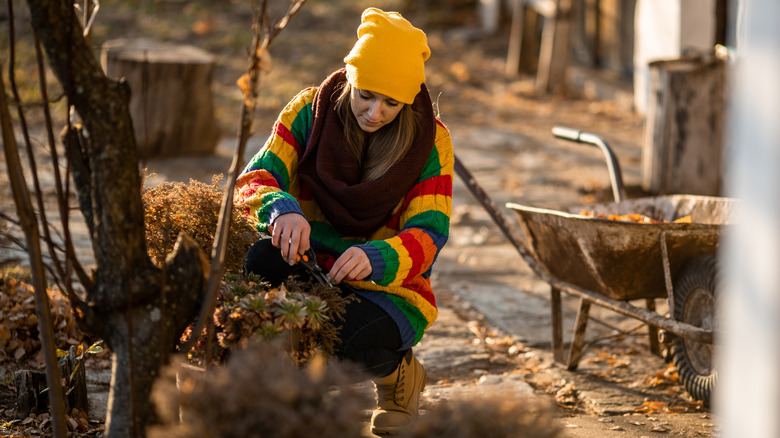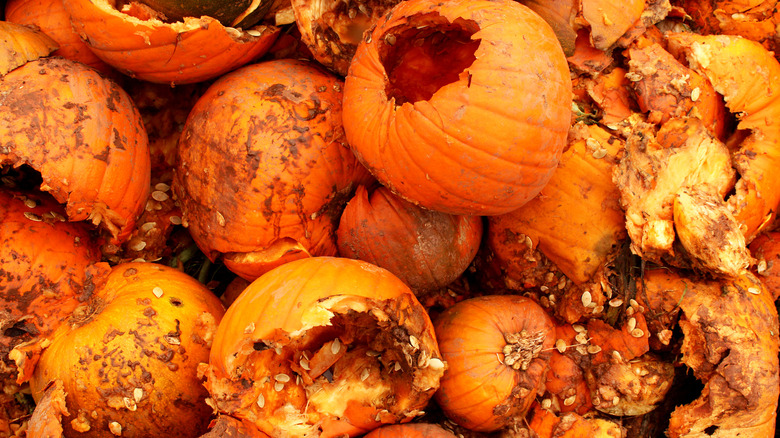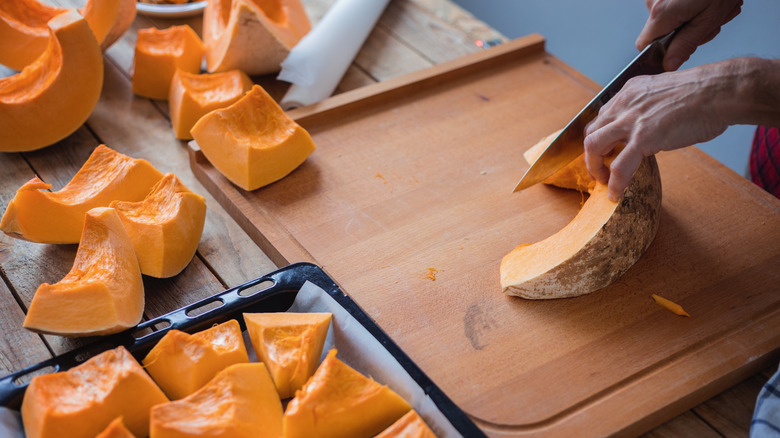The Unexpected Fall Ingredient You'll Want To Use In The Garden As It Gets Cold
For those in cooler climates, it's important to protect your garden from the cold throughout the fall and winter. Cold temperatures can cause damage to plants, especially frost-sensitive ones. Freezing temperatures can kill or damage plant cells, leading to wilting, browning, and even death. Moreover, cold weather can also cause the soil to freeze, which can hinder root growth and nutrient uptake, weakening plants and making them more susceptible to diseases and pests. Winter weather can also lead to soil erosion, as heavy rains or snowmelt can wash away topsoil and expose plant roots. One of the best ways to prevent these scenarios is to protect the ground in which your plants grow by spreading a layer of mulch before the cold sets in.
Mulch can help in protecting your garden from the cold by providing insulation. A layer of mulch acts as a barrier between the soil and the cold air, helping to regulate soil temperature and prevent extreme fluctuations. This insulation helps to keep the soil warmer, which in turn keeps the roots of plants protected. Mulch also helps to retain moisture in the soil, preventing it from drying out during the winter months. Purchasing large amounts of mulch can be costly, though, and transferring it from a delivery or truck is time-consuming. Fortunately, repurposing your old pumpkins may be just the trick you need to easily mulch your garden.
Why pumpkin mulch is beneficial to your garden
Pumpkins make excellent mulch in the garden for several reasons. Most pumpkins that are tossed in the trash once their usefulness has passed end up in landfills where they contribute to the growing issue of releasing toxic greenhouse gasses. NPR states, "Americans are spending hundreds of millions of dollars on the gourds annually, just to toss them in the trash when Halloween ends." By upcycling them into your garden, you reduce your carbon footprint while also providing benefits to the future plants you'll grow next season.
In addition to protecting the soil, pumpkins also contribute valuable nutrients as they decompose. In an interview with NPR, a program specialist at Ohio State University Extension stated how pumpkins can benefit the garden. Specialist Marne Titchenell recommended that it's best to upcycle pumpkins at the end of the season by adding them back to the soil, providing nutrients to fertilize future plants. This organic matter improves the soil structure, making it more fertile and better able to retain moisture.
Another benefit of using pumpkin mulch is its ability to suppress weeds. The thick layer of mulch acts as a barrier, preventing weed seeds from germinating and competing with the desired plants for nutrients and space. Finally, pumpkin mulch can also attract beneficial insects to the garden. As the mulch decomposes, it provides a food source for insects such as earthworms, which help to aerate the soil and improve its overall health.
How to make pumpkin mulch and use it in the garden
Turning your leftover pumpkins into mulch for your garden only requires a few simple steps. First, gather all the pumpkins that you have and remove any decorations or candles that may be inside. It's important to use only pumpkins that are free from any additives or chemicals, as these can be harmful to your plants and soil. If you decorated them with synthetic dyes or paints, these pumpkins are not great candidates for mulching.
Next, cut or smash the pumpkins into smaller pieces. You can use a sharp knife or a garden pruner to do this. The size of the pieces doesn't have to be uniform, but smaller pieces will decompose faster and be easier to spread as mulch. Collect your pieces in a wheelbarrow or large bucket for easy transfer to your garden. Next, spread a layer of the pumpkin pieces around your plants, making sure to cover the soil completely with 2-4 inches of height. If you don't have enough pumpkins, you may want to supplement your mulch with other organic materials such as wood chips or lawn clippings.
It's important to note that the decomposition process may take several weeks or even months, depending on the weather conditions and the size of the pumpkin pieces. Throughout the decomposition process, you may need to add more pumpkin pieces to maintain a consistent layer of mulch. This will ensure that your soil remains protected and enriched.


